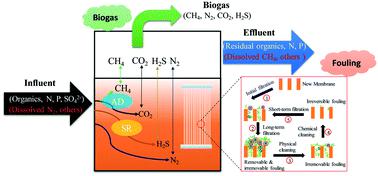当前位置:
X-MOL 学术
›
Environ. Sci.: Water Res. Technol.
›
论文详情
Our official English website, www.x-mol.net, welcomes your
feedback! (Note: you will need to create a separate account there.)
A review of anaerobic membrane bioreactors for municipal wastewater treatment with a focus on multicomponent biogas and membrane fouling control
Environmental Science: Water Research & Technology ( IF 3.5 ) Pub Date : 2020-07-27 , DOI: 10.1039/d0ew00528b Yisong Hu 1, 2, 3, 4, 5 , Hui Cheng 5, 6, 7, 8, 9 , Jiayuan Ji 5, 6, 7, 8, 9 , Yu-You Li 5, 6, 7, 8, 9
Environmental Science: Water Research & Technology ( IF 3.5 ) Pub Date : 2020-07-27 , DOI: 10.1039/d0ew00528b Yisong Hu 1, 2, 3, 4, 5 , Hui Cheng 5, 6, 7, 8, 9 , Jiayuan Ji 5, 6, 7, 8, 9 , Yu-You Li 5, 6, 7, 8, 9
Affiliation

|
Among the various anaerobic digestion technologies developed for wastewater treatment and resource recovery, the anaerobic membrane bioreactor (AnMBR) stands out as a viable alternative to traditional processes. However, the practical use of the AnMBR to treat a huge amount of low to moderate strength wastewater, like municipal wastewater (MWW), at ambient temperature, remains a challenge due to the membrane fouling issue and a low bioenergy recovery efficiency. In this review, the basics of the AnMBR process regarding membrane and bioreactor configurations are introduced. Then, the performance of the AnMBR with regard to pollutant removal and biogas production is discussed with special emphasis on analyzing the origin and fate of multicomponent biogas in the liquid–gaseous phases based on theoretical predictions and reported experimental results. A review of the studies on the mechanisms of membrane fouling is included together with an overview of the commonly used fouling control measures to support long-term sustainable AnMBR operation. Lastly, the technical challenges in enhancing AnMBR development from a number of different perspectives are pointed out. Applying AnMBR for the treatment of low-strength wastewater should be further optimized to enhance the techno-economic feasibility for full-scale operation, and more research attention should be given to the redirection of organics and nutrients to achieve a more economical process with improved environmental benefits.
中文翻译:

厌氧膜生物反应器用于市政废水处理的综述,重点是多组分沼气和膜污染控制
在为废水处理和资源回收开发的各种厌氧消化技术中,厌氧膜生物反应器(AnMBR)脱颖而出,可以替代传统工艺。然而,由于膜结垢问题和生物能源回收效率低,在环境温度下实际使用AnMBR来处理大量的中低强度废水,例如市政废水(MWW),仍然是一个挑战。在这篇综述中,介绍了有关膜和生物反应器配置的AnMBR工艺的基础。然后,讨论了AnMBR在污染物去除和沼气生产方面的性能,并特别强调了基于理论预测和报告的实验结果分析液相中多组分沼气的起源和归宿。包括对膜污染机理的研究综述,以及对支持长期可持续AnMBR操作的常用污染控制措施的概述。最后,指出了从多个不同角度增强AnMBR开发的技术挑战。应进一步优化将AnMBR用于处理低浓度废水的方法,以提高大规模运行的技术经济可行性,并且应更加关注有机物和营养物的重定向,以实现更经济的过程并改善环境。好处。指出了从多个不同角度增强AnMBR开发的技术挑战。应进一步优化将AnMBR用于处理低浓度废水的方法,以提高全面运行的技术经济可行性,并且应更加关注有机物和营养物的重定向,以实现更经济的过程并改善环境。好处。指出了从多个不同角度增强AnMBR开发的技术挑战。应进一步优化将AnMBR用于处理低浓度废水的方法,以提高全面运行的技术经济可行性,并且应更加关注有机物和营养物的重定向,以实现更经济的过程并改善环境。好处。
更新日期:2020-10-02
中文翻译:

厌氧膜生物反应器用于市政废水处理的综述,重点是多组分沼气和膜污染控制
在为废水处理和资源回收开发的各种厌氧消化技术中,厌氧膜生物反应器(AnMBR)脱颖而出,可以替代传统工艺。然而,由于膜结垢问题和生物能源回收效率低,在环境温度下实际使用AnMBR来处理大量的中低强度废水,例如市政废水(MWW),仍然是一个挑战。在这篇综述中,介绍了有关膜和生物反应器配置的AnMBR工艺的基础。然后,讨论了AnMBR在污染物去除和沼气生产方面的性能,并特别强调了基于理论预测和报告的实验结果分析液相中多组分沼气的起源和归宿。包括对膜污染机理的研究综述,以及对支持长期可持续AnMBR操作的常用污染控制措施的概述。最后,指出了从多个不同角度增强AnMBR开发的技术挑战。应进一步优化将AnMBR用于处理低浓度废水的方法,以提高大规模运行的技术经济可行性,并且应更加关注有机物和营养物的重定向,以实现更经济的过程并改善环境。好处。指出了从多个不同角度增强AnMBR开发的技术挑战。应进一步优化将AnMBR用于处理低浓度废水的方法,以提高全面运行的技术经济可行性,并且应更加关注有机物和营养物的重定向,以实现更经济的过程并改善环境。好处。指出了从多个不同角度增强AnMBR开发的技术挑战。应进一步优化将AnMBR用于处理低浓度废水的方法,以提高全面运行的技术经济可行性,并且应更加关注有机物和营养物的重定向,以实现更经济的过程并改善环境。好处。











































 京公网安备 11010802027423号
京公网安备 11010802027423号